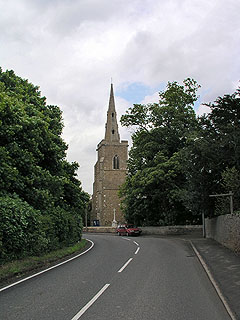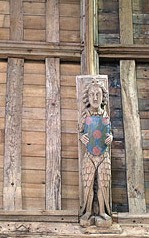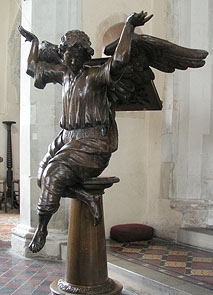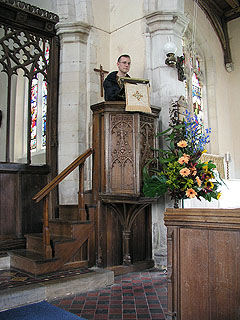The church was locked when we arrived, but a keyholder was listed, so Mark zipped off to fetch the key while I investigated the exterior of the church. The 14th century west tower has a very handsome spire, and a very weathered gargoyle puffs its cheeks on the porch. The churchyard was full of flowering laburnum, and I sat on a bench and watched the sky darken behind it.
Inside, the church is all of the 14th century. The roof is a lovely affair, tiebeams alternating with angels. These angels are full length, carrying painted shields.
The two over the screen are particularly good - they are dressed in long flowing coats of feathers or scale mail. There are two windows over where the rood would have been.
At the west end, the benches are extremely substantial and old looking. My instinct suggested that they were made from the base of the screen, as is quite common in places where the screen was taken down after the Reformation - but then, there's a very original looking screen still standing in the chancel arch.
The (particularly good) church guide suggests that the benches were brought from Jesus College, Cambridge at some point - but it also suggests that the screen is not original, because it doesn't quite fit into the arch. I'm not sure about that - it looked like a pretty good fit to me - but assuming that they're right, it leaves a further mystery concerning where the original screen ended up.
The pulpit has some original traceried panels, and there are some heraldic misericords in the choir. A startling contrast is given by the lectern, which is in the form of a big, seated angel with arms and wings outstretched. Pevsner reports that it was the support of a Dutch pulpit, and came here in 1882 via an antique dealer in York. This really is a church full of little treasures. On the wall next to the pulpit there are some remains of delicate painted vines and swirls.
The east window is full of a glorious jumble of medieval stained glass, and some fragments remain in the tops of some of the aisle windows. The north aisle contains a very substantial parish chest and a canopied easter sepulchre, with little faces looking out from the elaborate carving.
Until recently, the Rector of Landbeach was traditionally one of the senior fellows at Corpus Christi College down in Cambridge. The most famous of these was Matthew Parker, who was Rector at the same time as being Master of the College from 1545 to 1554. He later went on to be chaplain to Anne Boleyn.
He went into hiding under Mary, having been one of the principle supporters of Lady Jane Grey for the throne. With Elizabeth, though, the Cambridge cabal at the head of the Edwardian reformation returned triumphantly to the limelight.
Parker was made Archbishop of Canterbury, and played a key part in steadying the Anglican church in its infancy. One wonders, given his importance, whether he ever devoted much time to his parish at Landbeach - but they seem to be rather proud of him, anyway.
All Saints was locked, but keyholders were listed



